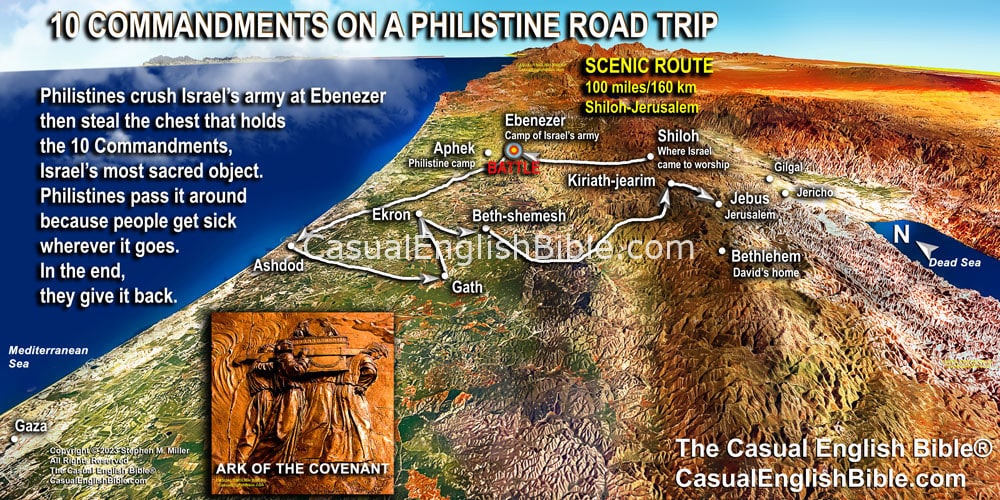1 Samuel 5
Plague of killer bumps
Ten Commandments in a Philistine temple
1Philistines overran Israel’s camp at Ebenezer and captured the sacred box [1] that held the Ten Commandments. They took it to one of their towns, Ashdod. [2]2Philistines put the box of God on display beside an image of their god Dagon, [3] inside Dagon’s Temple. 3The next morning, when Philistines went into Dagon’s Temple, their god was face-down on the floor, sprawled out in front of the box of the LORD. Dagon worshipers picked up the idol of their god and put it back where it belonged.
4Same thing again the next morning. This time, Dagon’s head and hands had snapped off. He was a headless, hands-free stump of a body lying there in front of God’s box. Dagon’s broken hands lay on the threshold at the entrance to the temple. 5That’s why Dagon’s priests in Ashdod stopped walking on the threshold when they came inside the temple or left. They stepped over it. They still do.
God sends a plague of bumps
6The LORD gave Ashdod Philistines a sampling of his power. He hammered them with a plague that produced bumps on their bodies. [4] This disease terrified people throughout Ashdod and beyond, into communities around them.7Citizens in Ashdod saw what was happening and they said, “We’ve got to get this box out of here. Israel’s God is hitting us hard. And he’s hitting our god, Dagon, too.”
8They sent messengers to the scattered Philistine leaders, asking, “What should we do about the box of Israel’s God?” The leaders said, “Let’s move the box out of town and send it to Gath.” [5] So that’s what they did. They sent the box to Gath. 9But God hammered the people of Gath in the same way as before, which panicked the people. Bumps erupted on everyone from kids to seniors.
10So, they sent to box of Israel’s God to Ekron. [6] It was not well received. The people protested and said “This box of Israel’s God will kill us. Why on earth did you bring it here? Do you want to kill us all?”
11With three cities rejecting the box, Philistines called a meeting. They brought in their leaders. They said, “We’ll send the box of Israel’s God back to where it came from. We’ll let it find its own way home. We don’t want our people to have any contact with it because it can kill them.” Entire Philistine cities were in a panic over this deadly plague. God had hit them hard.
12Philistines lucky enough to survive the plague still had to deal with the bumps. People throughout the towns wept openly and loudly, in sickness and grief. Screams filled the city air.
Footnotes
This box is also known as the Ark of the Covenant, or the Box of the Law. It was Israel’s most sacred relic. It was a wooden chest plated with gold all over. Inside that chest was a golden jar with some manna, Aaron’s almond wood staff that budded, and stone tablets engraved with the Ten Commandments. Covering the chest was a lid with figures representing glorious celestial beings called cherubim. This was the place where God’s people found forgiveness (Exodus 25:10-22; Hebrews 9:4-5). It’s where God met them in the rituals they performed there and in visions seen or heard by leaders like Moses and Samuel.
Ashdod was one of five leading Philistine cities along the eastern coast of the Mediterranean Sea. It was roughly 25 miles (40 km) south of the Philistine army camp at Aphek and the nearby Israelite camp at Ebenezer. That’s a long day’s march. Twenty miles a day was a typical day’s journey in the region. The other four leading Philistine towns were Gath, Ekron, Gaza, and Ashkelon. Ashkelon is the only one not visited by the Box of the Law.
Philistines may have put the box in Dagon’s temple as a war trophy, for bragging rights. It implied that Dagon was stronger than Israel’s God. Dagon was the Philistine top god, but it’s unclear what his specialty was. One hint is that the Hebrew and the Canaanite word dagan means grain. He could have been the go-to god for farmers. Philistines didn’t have exclusive rights to Dagon. People worshiped him throughout what is now called the Middle East. When Philistines invaded the coastland, perhaps about the same time Hebrew ancestors of the Jewish people were arriving in Canaan, they may have adopted the Dagon religion.
The questions are, what kind of bumps, and where? Were they high, low, and everywhere? Or were they just low and inside? The Hebrew word is opel, not a jewel, but a hemorrhoid. That’s one common way of translating the word. If that’s what the Philistines got, they probably also had a little something extra—something that popped out those uncomfortable bumps: diarrhea. But the writer seems to suggest that the sickness killed people (5:11-12). We might say our hemorrhoids are killing us, but they’re not. Most scholars today seem to say the bumps were tumors, possibly from bubonic plague, which rats can spread. The first Greek translation of the Jewish Bible, called the Septuagint, mentioned mice in the story. One Greek historian, Herodotus, said Assyrian King Sennacherib, besieging Jerusalem, had to retreat and go home after mice overran the camp of his army. The Bible version of the story says many soldiers died and the army left suddenly, overnight (2 Kings 18-19).
We’re left to wonder if Gath was the only Philistine town not represented at the meeting. Gath was roughly 15 miles (34 km) east of Ashdod, almost a day’s walk away.
Ekron was a little more than 10 miles (16 km) northeast of Gath, closer to the coast. It was about a half-day trip each way.
Discussion Questions
- Sorry, there are currently no questions for this chapter.






